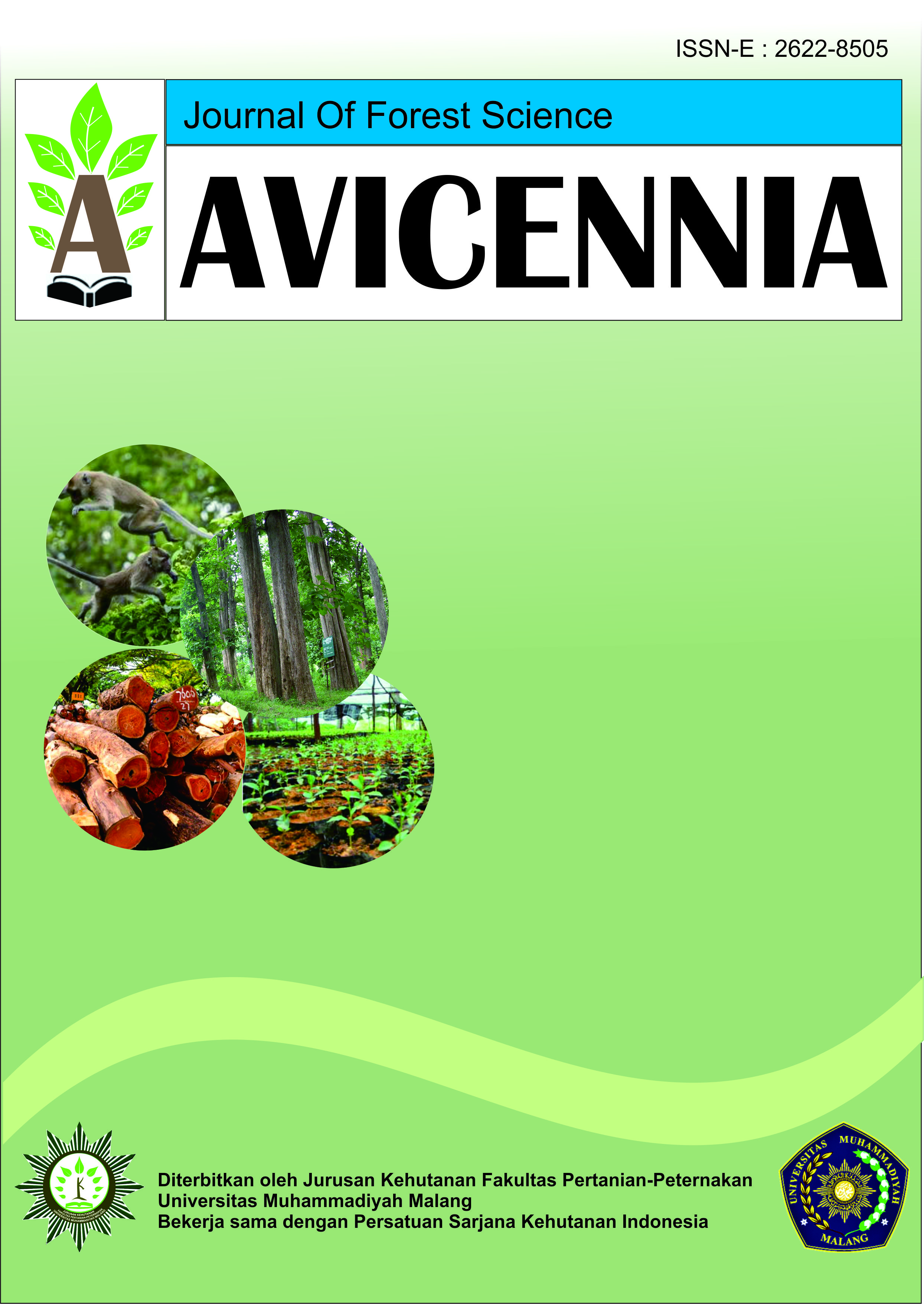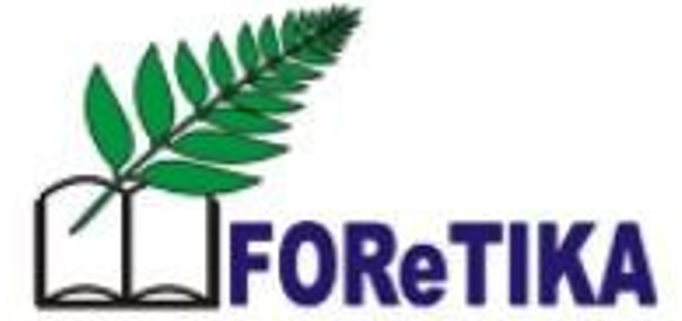Keanekaragaman Tumbuhan di Kawasan Hutan Mangrove Pangarengan Cirebon
DOI:
https://doi.org/10.22219/avicennia.v4i2.18180Keywords:
Taksonomi, identifikasi tumbuhan, keanekaragaman hayati, perairanAbstract
Mangrove Pangarengan yang terletak di Pesisir Kecamatan Pangenan, Kabupaten Cirebon masih terbatas informasi tentang keanekaragaman tumbuhannya. Penelitian ini bertujuan untuk mengetahui keanekaragaman tumbuhan yang ada di kawasan hutan mangrove Pangarengan Cirebon. Penelititan ini merupakan penelitian deskriptif dengan pengambilan data menggunakan metode jelajah. Analisis data dilakukan dengan menggunakan metode deskripsi keanekaragaman tumbuhan (description method to species diversity). Identifikasi dan klasifikasi data berdasarkan jenis yang ditemukan. Berdasarkan hasil penelitian, ditemukan sebanyak 24 spesies tumbuhan yang berasal dari kelas yang sama yaitu Magnoliopsida, dan terdiri atas 10 ordo, 15 Famili, dan 23 Genus. Famili yang paling banyak ditemukan adalah Asteraceae yaitu sebanyak 5 spesies. Perawakan tumbuhan yang dijumpai pada penelitian ini adalah pohon, liana, perdu, dan herba. Berdasarkan hasil pengamatan di lapangan, tumbuhan yang mendominasi di kawasan hutan mangrove Pangarengan adalah mangrove sejati Rhizophora mucronata yang banyak tumbuh di sepanjang tepi sungai, dan Avicennia marina yang banyak ditemukan di sepanjang tepi laut
Downloads
References
Antara. (2010). Indonesia Miliki 47 Jenis Ekosistem Alami. http://lipi.go.id/berita/indonesia-miliki-47-jenis-ekosistem-alami/5099. Diakses tanggal 5 September 2021.
Al-Snafi, A. E. (2016). Chemical constituents and pharmacological effects of Clerodendrum inerme-A review. SMU Medical Journal, 3(1), 129-153.
Ali, M., Kenganora, M., & Manjula, S. N. (2016). Health benefits of Morinda citrifolia (Noni): A review. Pharmacognosy Journal, 8(4).
Badan Lingkungan Hidup Daerah Kabupaten Cirebon. (2014). Laporan Status Lingkungan Hidup Daerah Kabupaten Cirebon Tahun 2014. Diakses dari http://blhd.cirebonkab.go.id/wp-content/uploads/2015/03/SLHD-2014.pdf
Bandaranayake, W. M. (1998). Traditional and medicinal uses of mangroves. Mangroves and salt marshes, 2(3), 133-148.
DeFilipps, R. A., Maina, S. L., & Crepin, J. (2004). Medicinal plants of the Guianas (Guyana, Surinam, French Guiana). Medicinal Plants of the Guianas (Guyana, Surinam, French Guiana).
Galani, V. J., Patel, B. G., & Rana, D. G. (2010). Sphaeranthus indicus Linn.: A phytopharmacological review. International Journal of Ayurveda Research, 1(4), 247.
GBIF Secretariat (2021). GBIF Backbone Taxonomy. Checklist dataset https://doi.org/10.15468/39omei accessed via GBIF.org on 2021-07-21.
Giesen, W., Wulffraat, S., Zieren, M., & Scholten, L. (2006). Mangrove guidebook for Southeast Asia. FAO, Bangkok.
Giri, C., Ochieng, E., Tieszen, L.L., Zhu, Z., Singh, A., Loveland, T., Masek, J., & Duke, N. (2011). Status and distribution of mangrove forest of the world using earth observation satellite data. Globarl Ecology and Biogeography, 20, 154-159.
Guha, G., Rajkumar, V., Ashok Kumar, R., & Mathew, L. (2011). Therapeutic potential of polar and non-polar extracts of Cyanthillium cinereum in vitro. Evidence-based complementary and alternative medicine, 784826
Hamdi, A. S., & Bahruddin, E. (2015). Metode penelitian kuantitatif aplikasi dalam pendidikan. Deepublish.
Hanum Zubaedah. (2020). RI Miliki Megabiodiversity Terbesar Ke-2 Di dunia, Ini Alasannya.https://mediaindonesia.com/humaniora/361101/ri-miliki-megabiodiversity-terbesar-ke-2-di-dunia-ini-alasannya. Diakses tanggal 5 september 2021.
Imran, I., Hussain, L., Zia-Ul-Haq, M., Janbaz, K. H., Gilani, A. H., & De Feo, V. (2011). Gastrointestial and respiratory activities of Acacia leucophloea. Journal of ethnopharmacology, 138(3), 676-682.
Ilodibia, C. V., Ewere, F. U., Akachukwu, E. E., Adimonyemma, R. N., Igboabuchi, N. A., & Okeke, N. F. (2016). Proximate composition, vitamin and anatomical studies on Gomphrena celosioides. Annual Research & Review in Biology, 10(3).1-6.
Kaur, M. & Nitika (2015). Review on Sea purslane. Journal of Pharmacognosy and Phytochemistry, 3(5). 22-24
Kumar, D., Kumar, S., Gupta, J., Arya, R., & Gupta, A. (2011). A review on chemical and biological properties of Cayratia trifolia Linn.(Vitaceae). Pharmacognosy reviews, 5(10), 184.
Kustanti, A. (2011). Manajemen Hutan Mangrove. IPB Press. Bogor. 248 p.
Mohale, D. S., Dewani, A. P., Chandewar, A. V., Khadse, C. D., Tripathi, A. S., & Agrawal, S. S. (2009). Brief review on medicinal potential of Terminalia catappa. Journal of Herbal Medicine and Toxicology, 3(1), 7-11.
Nguyen, P. D., Abedini, A., Gangloff, S. C., & Lavaud, C. (2018). Antimicrobial Constituents from Leaves of Dolichandrone spathacea and Their Relevance to Traditional Use. Planta Medica International Open, 5(01), e14-e23.
Reddy, A. K., Joy, J. M., & Kumara, C. A. (2011). Lannea coromandelica: The Researcher's Tree. Journal of pharmacy research, 4(3), 577-579.
Sidik, F., Prasetio, H., Kusuma, D.W., & Suhardjono. (2019). Panduan Mangrove: Survei Ekologi dan Pemetaan. Kementerian Kelautan dan Perikanan, LIPI, Conservation International Indonesia, USAID. Jakarta.
Sirinthipaporn, A., & Jiraungkoorskul, W. (2017). Wound healing property review of siam weed, Chromolaena odorata. Pharmacognosy reviews, 11(21), 35-38.
Supriharyono. (2000). Pelestarian dan Pengelolaan Sumber Daya Alam di Wilayah Pesisir Tropis. Gramedia Pustaka. Jakarta
Tropical Plants Database, Ken Fern. tropical.theferns.info. (2021)
Patil, A. S., Paikrao, H. M., & Patil, S. R. (2013). Passiflora foetida Linn: a complete morphological and phytopharmacological review. International Journal of Pharma and Bio Sciences, 4(1), 285-296.
Downloads
Published
Issue
Section
License
Copyright (c) 2021 Afni Atika Marpaung, Budi Mulyana, Ris Hadi Purwanto, Puspita Intan Sari, Muhamad Faqih Hidayatullah, Agik Dwika Putra, Ilham Satria Raditya Putra

This work is licensed under a Creative Commons Attribution 4.0 International License.
Authors who publish with this journal agree to the following terms:
- Authors retain copyright and grant the journal right of first publication with the work simultaneously licensed under a Creative Commons Attribution License that allows others to share the work with an acknowledgement of the work's authorship and initial publication in this journal.
- Authors are able to enter into separate, additional contractual arrangements for the non-exclusive distribution of the journal's published version of the work (e.g., post it to an institutional repository or publish it in a book), with an acknowledgement of its initial publication in this journal.
- Authors are permitted and encouraged to post their work online (e.g., in institutional repositories or on their website) prior to and during the submission process, as it can lead to productive exchanges, as well as earlier and greater citation of published work (See The Effect of Open Access).











